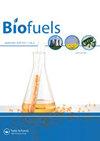脱臭馏出物生物柴油弹性体相容性及发动机性能的实验研究
IF 2.6
4区 工程技术
Q3 ENERGY & FUELS
引用次数: 1
摘要
摘要脱臭馏出物是植物油加工的主要废弃物。对脱臭馏出物进行了酯化和酯交换两步工艺,将其转化为生物柴油。对生产的生物柴油的性能进行了测量,发现其与柴油相当。目前的研究包括弹性体的相容性和生物柴油的发动机性能。第一节讨论了根据汽车工程师学会(SAE)标准使用生物柴油的几种汽车弹性体的稳定性和降解。本研究(根据SAE J1748)采用不同的科学技术介绍了生物柴油对汽车弹性体的降解行为。根据上述标准,进行静态浸渍试验以研究弹性体在常规柴油和生物柴油中的降解行为。结果表明,六种不同类型的弹性体与生物柴油一起使用时具有稳定性和可降解性。与其他弹性体相比,氟橡胶和氯丁橡胶在生物柴油和柴油中表现出更多的降解。丁腈橡胶(NBR)对柴油的伸长率约为715%,对生物柴油的伸长率为703%,而单独的聚氯乙烯(PVC)对柴油和生物柴油的拉伸强度分别提高了7.63%和15.2%。在燃烧和排放性能方面,生物柴油显示出令人满意的结果。本文章由计算机程序翻译,如有差异,请以英文原文为准。
Experimental investigation of elastomer compatibility and engine performance of biodiesel derived from deodorizer distillate
Abstract Deodorizer distillate is the primary waste product of the processing of vegetable oils. A two-step process, involving esterification and transesterification, was carried out on the deodorizer distillate to convert it into biodiesel. The properties of the produced biodiesel were measured and found to be comparable with diesel. The current study includes the compatibility of elastomers and the engine performance of biodiesel. The first section discusses the stability and degradation of several automotive elastomers with biodiesel according to Society of Automotive Engineers (SAE) standards. This study (as per SAE J1748) presents the degrading behavior of automotive elastomers with biodiesel using a different scientific technique. A static immersion test was conducted to study the degradation behavior of the elastomers when immersed in conventional diesel and biodiesel as per the standards mentioned above. The results show the stability and degradability of six different types of elastomers when used with biodiesel. Viton and neoprene showed more degradation in biodiesel and diesel than other elastomers. Nitrile butadine rubber (NBR) showed about 715% elongation for diesel and 703% elongation for biodiesel, while polyvinyl chloride (PVC) alone showed an increase in tensile strength of 7.63% and 15.2% for diesel and biodiesel, respectively. Regarding combustion and emissions performance, the biodiesel showed satisfactory results.
求助全文
通过发布文献求助,成功后即可免费获取论文全文。
去求助
来源期刊

Biofuels-Uk
Energy-Renewable Energy, Sustainability and the Environment
CiteScore
5.40
自引率
9.50%
发文量
56
期刊介绍:
Current energy systems need a vast transformation to meet the key demands of the 21st century: reduced environmental impact, economic viability and efficiency. An essential part of this energy revolution is bioenergy.
The movement towards widespread implementation of first generation biofuels is still in its infancy, requiring continued evaluation and improvement to be fully realised. Problems with current bioenergy strategies, for example competition over land use for food crops, do not yet have satisfactory solutions. The second generation of biofuels, based around cellulosic ethanol, are now in development and are opening up new possibilities for future energy generation. Recent advances in genetics have pioneered research into designer fuels and sources such as algae have been revealed as untapped bioenergy resources.
As global energy requirements change and grow, it is crucial that all aspects of the bioenergy production process are streamlined and improved, from the design of more efficient biorefineries to research into biohydrogen as an energy carrier. Current energy infrastructures need to be adapted and changed to fulfil the promises of biomass for power generation.
Biofuels provides a forum for all stakeholders in the bioenergy sector, featuring review articles, original research, commentaries, news, research and development spotlights, interviews with key opinion leaders and much more, with a view to establishing an international community of bioenergy communication.
As biofuel research continues at an unprecedented rate, the development of new feedstocks and improvements in bioenergy production processes provide the key to the transformation of biomass into a global energy resource. With the twin threats of climate change and depleted fossil fuel reserves looming, it is vitally important that research communities are mobilized to fully realize the potential of bioenergy.
 求助内容:
求助内容: 应助结果提醒方式:
应助结果提醒方式:


